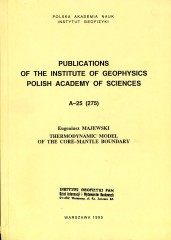- A - Physics of the Earth's Interior
- B - Seismology
-
C - Geomagnetism
C-119, C-118, C-117, C-116, C-115, C-114, C-113, C-112, C-111, C-110, C-109, C-108, C-107, C-106, C-105, C-104, C-103, C-102, C-101, C-100, C-99, C-98, C-97, C-96, C-95, C-94, C-93, C-92, C-91, C-90, C-89, C-88, C-87, C-86, C-85, C-84, C-83, C-82, C-81, C-80, C-79, C-78, C-77, C-76, C-75, C-74, C-73, C-72, C-71, C-70, C-69, C-68, C-67, C-66, C-65, C-64, C-63, C-62, C-61, C-60, C-59, C-58, C-57, C-56, C-55, C-54, C-53, C-52, C-51, C-50, C-49, C-48, C-47, C-46, C-45, C-44, C-43, C-42, C-41, C-40, C-39, C-38, C-37, C-36, C-35, C-33, C-32, C-31, C-30, C-29, C-28, C-27, C-26, C-25, C-24, C-23, C-22, C-21, C-20, C-19, C-18, C-17, C-16, C-15, C-14, C-13, C-12, C-11, C-10, C-9, C-8, C-7, C-6, C-5, C-4, C-3, C-2, C-1
-
D - Physics of the Atmosphere
D-79, D-78, D-77, D-76, D-75, D-74, D-73, D-72, D-71, D-70, D-69, D-68, D-67, D-66, D-65, D-64, D-63, D-62, D-61, D-60, D-59, D-58, D-57, D-56, D-55, D-54, D-53, D-52, D-51, D-50, D-49, D-48, D-47, D-46, D-44, D-45, D-43, D-42, D-41, D-40, D-39, D-38, D-37, D-35, D-34, D-33, D-32, D-31, D-30, D-28, D-27, D-26, D-25, D-24, D-23, D-22, D-21, D-20, D-19, D-18, D-17, D-16, D-15, D-14, D-13, D-12, D-11, D-10, D-9, D-8, D-7, D-6, D-5, D-4, D-3, D-2, D-1
- E - Hydrology
- P - Polar Research
- M - Miscellanea
-
Online First
Thermodynamic Model of the Core-mantle Boundary
Volume: 275
Series: A-25
High pressure atomic diffusion of Fe0.94O from the mantle to the liquid outer core, solution of Fe0.94O in the liquid outer core, melting of FeS-troilite at the core-mantle boundary in the Earth, and diffusion of liquid iron from the outer core to D'' layer, are modelled. The core-mantle boundary is treated as a phase boundary and a surface of solution. The liquid outer core is modelled as a solution layer. Some interactions between the core-mantle boundary and the inner core boundary are considered. It is assumed the Fe0.94O soluted and FeS-troilite melted at the core-mantle boundary are transported in the process of thermal convection in the outer core to the inner core boundary. Next, Fe0.94O precipitates and FeS-troilite crystallizes at the inner core boundary. Local equations for the diffusion-controlled and interface-reaction-controlled rates of mass transfer across the core-mantle boundary are derived. It was estimated that the ratio of the interface-reaction-controlled rate and the diffusion-controlled rate is 0.6 which means that both mechanisms play an important role in the entire mass transfer process at the core-mantle boundary. Two models are considered. In Model A we assumed that the mass transfer is proceeding only in one direction: from the mantle to the core. In Model B we assumed that there exists a mutual exchange of mass between the mantle and core, i.e., we face diffusion from the mantle to the core and at the same time we have diffusion from the core to the mantle. Eventually, in the framework of Model A it was found that the diffusion-controlled rates of mass tranfer of Fe0.94O and FeS-troilite from the mantle to the liquid outer core are 2200 kg/m2/year and 400 kg/m2/year, respectively. Consequently, Fe0.94O and Fes-troilite are transported from the mantle into the liquid outer core with the speed of 22 cm/year and 4 cm/year, respectively, with respect to the core-mantle boundary. In Model A the liquid outer core and solid inner core are growing. In the framework of Model B the mass transport from the core and from the mantle are equivalent and the core-mantle boundary in this model is not moving.
CONTENTS
Abstract, ...3
1. Chemical reactions between the Earth´s core and mantle, ...3
2. Observational evidence, ...6
3. Fundamental assumptions, ...22
4. Modelling of the core-mantle boundary, ...24
5. Dissipation jump condition, ...26
6. The second law of thermodynamics, ...27
7. Continuity of temperature, ...27
8. Interfacial balance laws, ...27
9. Particular balance equations, ...28
10. Thermodynamics of chemical reactions at high temperature and high pressure, ...32
10.1 Temperature and pressure dependence of the Gibbs free energy, ...32
10.2 Heat capacity at high temperature, ...33
10.3 Molar volume at high temperature and high pressure, ...34
10.4 Solid solution models, ...36
11. Melting and solidification of iron sulfide in D´´ layer, ...38
12. Diffusion, solution and precipitation of iron oxide, ...41
13. Interactions between the core-mantle boundary and the inner core boundary, ...45
14. Numerical results for Fe0.94O ad FeS-troilite, ...49
15. Concluding discussion, ...52
Acknowledgment, ...53
References, ...53
Streszczenie, ...59


